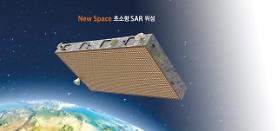
[Courtesy of KARI]
South Korea's space program has seen slow progress as advanced countries were reluctant to transfer core technologies. Three space rockets have been launched but two fired in 2009 and 2010 failed to reach the earth's targeted orbit. The third one using Russian technology put a satellite into orbit in 2013. Some 1.96 trillion won ($1.68 billion) has been invested in the space program that began in 2010 to secure independent space transport capabilities.
The state-run Korea Aerospace Research Institute (KARI) was in charge of designing the Korea Space Launch Vehicle-2 (KSLV-2), known as "Nuri" capable of deploying 1.5-ton satellites into 600 to 800 kilometers (497 miles) of orbit. In November 2018, South Korea's first homemade booster engine was successfully launched and showed stable performance. The test rocket reached a maximum height of 209 km. Four months later, engineers produced the prototype of full-size propellant tanks to be mounted on the first stage of Nuri.
The dates for Nuri's two test launches to put model and performance verification satellites into orbit at an altitude of 700 km were approved at a meeting chaired by Science and ICT Minister Lim Hye-sook on August 12. The first launch on October 21 at the Naro Space Center in the southern coastal town of Goheung will carry a dummy satellite. A 0.2-ton performance verification satellite and a 1.3-ton dummy satellite will be used for the second launch on May 19 in 2022.
"Nuri is South Korea's independent space launch vehicle, which has been developed with sweat by many researchers and industry officials since 2010. It will mark a milestone in the history of our space development," Lim said. Final permission will be made in late September after a state committee closely monitored the results of a wet dress rehearsal for system tests and ground support equipment.
The homemade launch system is 47.2 meters long and weighs about 200 tons. The first stage uses a cluster of four 75-ton liquid engines. A 75-ton liquid engine was designed for the second stage and a seven-ton liquid engine for the third stage. The engine consists of a fuel tank, a combustion chamber, the turbopump which forces fuel at high pressure towards the combustion chamber, and control valves that regulate the flow of fuel into the chamber.
Combustion tests have been carried out continuously to improve engine reliability. According to a report by an evaluation team of 15 external experts, a certification test of Nuri's launch pad and engines has been successfully completed. Sensors installed on the Nuri launch vehicle would be used to see if a model satellite will enter its target orbit.
Kwon Hyun-joon of the science ministry's space, nuclear and big science policy bureau, expressed guarded optimism. "We don't think there will be any problems because we use parts with proven functions, but there may be problems when they are completely assembled."
South Korea's mid-term goal is to develop solid-propellant boosters, put a lot of small low-orbit satellites into orbit and raise the localization rate of high-tech space components for satellites and launchers. Liquid-propellant rockets offer more efficient and controllable alternatives, but solid rockets are used in military armament or as light launch vehicles because of their simplicity and reliability.
The long-term goal is to develop platforms for the launch of space rockets using aircraft or at sea. Most launch vehicles take off from sites on land. The advantages of an air-based launch are flexibility in the launch location. Sea launch provides flexible positioning. A mobile sea platform allows launches closer to the equator. The greater rotational speed of the Earth near the equator means lower fuel requirements to achieve orbit.
The launch of Nuri in October underlines efforts by the Seoul government to push for a policy shift to foster a civilian-led space industry. Washington revised missile guidelines in 2020, allowing South Korean individuals and entities to develop, produce and possess space launch vehicles using solid fuel.
In June 2021, South Korea's top economic official Hong Nam-ki proposed the development of more than 100 ultra-small public satellites by 2031 to secure competitiveness in satellite communication technologies which are essential for the commercialization of 6G, urban air mobility (UAM) and a space internet service. A flight test center in Goheung has been designated as a testbed for drone taxis that will be commercialized in 2025.
Copyright ⓒ Aju Press All rights reserved.



